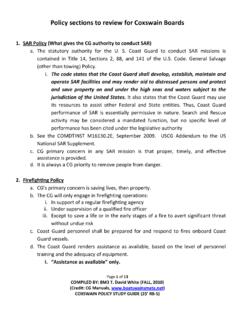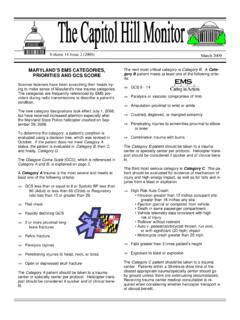Transcription of Overview of environmental law in Western Australia
1 Overview of environmental law in Western AustraliaEnvironmental Defender s Office of Western Australia (Inc.)Fact Sheet01 Important disclaimer:This fact sheet is for general information purposes. Important legal details have been omitted to provide a brief Overview of this area of the law. If you require legal advice relating to your specific circumstances you should contact the environmental Defender s Office WA (Inc) or your solicitor. The EDO takes no responsibility for any loss or damage resulting from any error in this fact Introduction to the Overview of environmental law in Western AustraliaWestern Australia has a coastline of 12,500 kilometres and a land area of almost million square kilometres.
2 Within this vast region, the State is host to a diverse range of environments and native species of plants and animals, and the south west botanical province is classified as one of only 25 biodiversity hotspots on Earth. The State s environmental laws play an important part in protecting Western Australia s fact sheet provides an Overview of environmental regulation in Western Australia , including an examination of the roles of Commonwealth, State and local fact sheet is intended for information purposes only. If you require advice about a specific issue, please contact the EDO. This fact sheet is current as at March 2011. It is possible that changes to the law have been made since this time.
3 Updated March 2011 What is environmental law ?The term environmental law refers to laws for protecting soil, air, water, the oceans and biodiversity, as well as laws which protect the environment as a whole. environmental laws can protect areas of land or ocean (such as in national parks), individual species (such as wildlife conservation laws), require environmental impact assessment be done before approvals are granted for an activity, make it an offence to harm the environment, and require people to remediate any environmental damage they cause (such as contaminated sites laws).There are many different environmental laws in WA. The details of these different laws are set out in the EDO WA fact sheet series.
4 The purpose of this fact sheet is to provide an Overview framework for understanding where those laws come from, and how they are of environmental lawEnvironmental law derives from five sources - common law, statute, subsidiary legislation, policies and administrative guidelines, and international law. Common lawCommon law refers to laws that have been developed by the courts over many years. Whilst most environmental laws derive from statutes (see below), there are a number of common law principles which are relevant to protecting the environment, particularly where the issue involves a dispute between neighbours (see Fact Sheet 2: Common law).1/11 Overview of environmental law in Western Australia01 Important disclaimer:This fact sheet is for general information purposes.
5 Important legal details have been omitted to provide a brief Overview of this area of the law. If you require legal advice relating to your specific circumstances you should contact the environmental Defender s Office WA (Inc) or your solicitor. The EDO takes no responsibility for any loss or damage resulting from any error in this fact Defender s Office of Western Australia (Inc.) StatuteStatutes are laws enacted by the State or Federal Parliament. A great deal of what is commonly referred to as environmental law is derived from statute (for example, the environmental Protection Act 1986 (WA) ( EP Act ). Statute law prevails over common law, although there is a presumption that a statute does not take away common law rights unless it clearly says so.)
6 Subsidiary legislationA statute may allow for the making of subsidiary legislation by government (rather than parliament). Subsidiary legislation contains local or specific details of how a statute applies. Examples of subsidiary legislation are local town planning schemes made by local governments under the Planning and Development Act 2005 (WA), and the environmental Protection Regulations 1987 (WA) made by the Department of Environment and Conservation ( DEC ) under the EP Act. Policies and administrative guidelinesAlthough not laws themselves, policies and administrative guidelines applied by government affect how particular laws are enforced and administered in practice. Statements of planning policy and guidelines to the environmental impact assessment process are examples of policies and guidelines that affect the way the law is applied by government authorities.
7 Policies and administrative guidelines are not binding documents on developers or government, but government must give them proper consideration when it is making a decision. International lawAustralia is a signatory to a number of international treaties. These treaties do not have direct legal effect in Australia until they are implemented by Commonwealth legislation. An example is the World Heritage Convention which is implemented by Australia in the Environment Protection and Biodiversity Conservation Act 1999 (Cth).Guiding principles of environmental lawIn developing new environmental legislation, law-makers are increasingly adopting a number of internationally recognised principles: ecologically sustainable development and the principle of intergenerational equity; the precautionary principle; conservation of biological diversity and ecological integrity; economic valuation of environmental factors and the polluter pays principle; waste minimisation; and public principles are not binding in themselves on developers or government, but government may be required to give them proper consideration when it is making a decision affected by these principles.
8 This is especially the case when a principle is stated to be an objective of a statute, or if the statute states the principle has to be taken into of environmental law in Western Australia01 Important disclaimer:This fact sheet is for general information purposes. Important legal details have been omitted to provide a brief Overview of this area of the law. If you require legal advice relating to your specific circumstances you should contact the environmental Defender s Office WA (Inc) or your solicitor. The EDO takes no responsibility for any loss or damage resulting from any error in this fact Defender s Office of Western Australia (Inc.)Who makes environmental law - roles of Commonwealth, State and local government CommonwealthThe Commonwealth Constitution gives specific law-making powers to the Commonwealth Parliament.
9 Although these powers do not specifically include the power to make laws about the environment (in fact the environment isn t even mentioned in the Commonwealth Constitution), the Commonwealth does have powers that may be exercised for the purposes of environmental regulation, including: control of interstate and overseas trade and commerce ( granting export licences with conditions that protect the environment); and external affairs ( implementation of the World Heritage Convention to protect world heritage areas).The Commonwealth may also exercise its financial powers to make laws about taxation and expenditure of Commonwealth money in ways which protect the environment.
10 For example, the Commonwealth may make grants to the States on conditions that the money be spent in a certain way, including ways which promote sustainable land an Overview of the most important Commonwealth environment laws, see Fact Sheet 6: Commonwealth environmental impact assessment, Fact Sheet 9: Biodiversity protection under Commonwealth law and Fact Sheet 17: Marine Western Australian Parliament has the power to make laws with respect to peace, order and good government of the State. This includes the power to make laws regulating the use of land and natural resources, and therefore also allows the State to make laws to regulate and manage how the use of the land and ocean impacts the environment.





